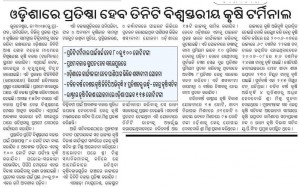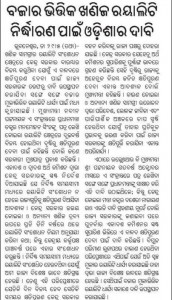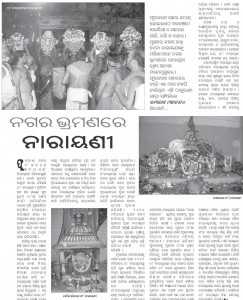Archive for May, 2008
Universities and university level Institutes in the greater Bhubaneswar area: existing and upcoming
Bhubaneswar and vicinity, Bhubaneswar- Cuttack- Puri, Khordha, Marquee Institutions: existing and upcoming, Puri, Universities: existing and upcoming, Wikimapia maps Comments Off on Universities and university level Institutes in the greater Bhubaneswar area: existing and upcomingCM writes to PM for Ad Valorem rates on minerals: Samaja
Ad Valorem, Chief Minister's actions, Mine royalty and cess, MINES and MINERALS, Samaja (in Odia) Comments Off on CM writes to PM for Ad Valorem rates on minerals: SamajaProgress on Astaranga and Kirtania ports: Dharitri
Astaranga, Puri (Navayuga interested), Balasore, Choumukha-Kirtania, Balasore (Creative ports, Chennai interested), Dharitri (in Odia), Puri Comments Off on Progress on Astaranga and Kirtania ports: DharitriInfosys plans for a 500 crore investment in Bhubaneswar
Akshay Patra Foundation, Bhubaneswar- Cuttack- Puri, HEALTHCARE and HOSPITALS, Indian majors, Infosys, IT, Khordha, TOI, Economic Times 2 Comments »Following is an excerpt from a report in Economic Times.
IT major Infosys today said it would invest Rs 500 crore in Orissa for setting up an SEZ in IT and ITeS sectors and take care of children’s mid-day-meal scheme and healthcare services.
“We have proposed to set up an IT SEZ in Bhubaneswar. The project will require 50 acres of land”, T V Mohandas Pai, Director HR, ER and administration and member of board of Infosys, told reporters here.
… Pai who had been funding mid-day meal for 10,000 school children in Nayagarh district, also agreed to extend the programme to Gajapati and Kandhamal districts, official sources said. Besides, 30,000 children in Puri district were also getting midday meal in Puri district.
“We have been spending Rs 6.50 per child to provide quality food,” Pai said pointing out that Infosys had spent Rs 5.5 crore towards its corporate social responsibility.
Shetty, who had been providing health care service to BPO staff, urged Patnaik to allot five-seven acres of land in the city for setting up a 1,000-bed heart hospital.
As the city was gradually becoming a IT hub of Eastern India with almost all major players opening their development centres, employees required quality heath service, Shetty said.
“We have also requestedthe state government to help Shetty set up a heart hospital here”, Pai told reporters.
Tatas plan a rural BPO in Kalinganagar
Business Standard, IT, Back office, BPO, Jajpur, Jajpur Rd- Vyasanagar- Duburi- Kalinganagar, Tatas Comments Off on Tatas plan a rural BPO in KalinganagarFollowing is an excerpt from a report in Business Standard.
The rural BPO centre will be established by the Tata Business Support Services (TBSS) — the BPO wing and a wholly-owned subsidiary of Tata Sons — in partnership with Tata Steel Rural Development Society — a corporate NGO managed by the Tata Group for the last 60 years. To start with, it is expected to employ around 200 people.
Sources close to the development said the company has already recruited the first batch of the executives for the BPO unit, who are expected to undergo two months of training at TBSS’ headquarters in Hyderabad. TBSS has developed a specialised training programme in view the fact that most of the new recruits are not computer literate. It currently operates three rural BPO units that employ around 500 people in all.
A spokesperson from Hyderabad-headquartered TBSS confirmed the move. A senior official of the Tata group said the company was looking for graduates and under-graduates with some knowledge of English.
The centre aims at handling the Orissa region front-end and customer support works of group companies including Tata Teleservices and Tata Sky. The BPO unit will also provide services to other firms who have substantial operations in Orissa.
“Opening the BPO unit in Kalinganagar will provide us access to many educated but unemployed youths in semi-urban areas like Jajpur Road and Duburi which have a number of colleges and educational institutions in and around. The education level among the masses in these areas is comparatively high and the aspirations level of the local people is also very high,”said a Tata group executive in charge of human resources development.
“Although most youths in these areas are interested in higher-end and computer-related jobs, there were no opportunity in these places,” the executive added.
The group will initially run the BPO unit in the transit houses and rehabilitation set-up established by the company in Kalinganagar, before moving into a dedicated building in next few months. The centre will start as a voice-based BPO with focus on Bengali, Hindi and English languages other than Oriya.
Inland water transport plan: Pioneer
Inland waterways Comments Off on Inland water transport plan: PioneerFollowing is an excerpt from a report in Pioneer.
The State Government has decided to build an inland water transport network in the State. All the rivers would be connected with the sea routes.
A decision to this effect was taken at a high level meeting chaired by Chief Minister Naveen Patnaik after IIT, Chennai presented a report to this effect to the State Government.
Patnaik directed the Commerce and Transport Department to prepare a Master Plan to develop the inland water system. In order to develop the inland water transport system, the State Government would spend Rs 1,500 crore in the first phase.
In its report, the IIT has stated that Orissa requires about 15 to 20 ports in the State in the coming years. The ports could be set up in the long coast line of 480 km.
By 2017, the State’s transportation of materials through sea routes would reach to a capacity of 300 million tonne per annum from a meager 60 million tone. It was decided in the meeting that Government would formulate a new policy on development of commerce through seas.
Puri-Bhubaneswar-Konark-Chilika among the 20 select tourist sites
Bhubaneswar- Cuttack- Puri, Chilika, Khordha, Konark, Puri, Sites in and around Bhubaneswar Comments Off on Puri-Bhubaneswar-Konark-Chilika among the 20 select tourist sitesFollowing is an excerpt from an IANS report in thaiindian.com.
India is developing 20 places, including Agra – home to the Taj Mahal – as short-halt destinations to attract more foreign tourists, the tourism ministry said here Tuesday. The 20 sites were selected on the basis of the number of national and international travellers visiting the place. Being a world heritage site was also a factor in the selection, the ministry statement said.
The tourism ministry will provide financial assistance of up to Rs.250 million for development of a mega destination and of Rs.500 million for a mega circuit.
“The ministry’s objective is to ensure that with enhanced investments and an integrated approach, the mega destinations will be developed to maximize their potential,†the tourism ministry’s statement said.
“The resulting increase in tourist inflows, in turn, will lead to economic development and employment generation in and around these places,†the statement added.
The sites are Agra – revitalization of the Taj (Uttar Pradesh), Varanasi-Sarnath (Uttar Pradesh), Bodhgaya-Rajgir-Nalanda (Bihar), illumination of monuments of Delhi (Delhi), Mahabalipuram (Tamil Nadu), Puri-Bhubaneswar-Konark-Chilka (Orissa), Haridwar-Rishikesh (Uttarakhand), Hampi (Karnataka), Gangtok (Sikkim), Ajmer-Pushkar (Rajasthan) and Kurukshetra (Haryana).
Other sites include Charminar area of Hyderabad (Andhra Pradesh), Jagdalpur-Tirathgarh-Chitrakoot-Barsoo (Chhattisgarh), Dwarka (Gujarat), Tirupati (Andhra Pradesh), Churches of Goa, Ganga Heritage River Cruise Circuit (West Bengal), Vidarbha Circuit (Maharashtra), Aurangabad (Maharashtra) and Amritsar (Punjab).
IDCO and Raheja sign MOU for an Mindspace type IT park
Bhubaneswar- Cuttack- Puri, IDCO projects, IT, IT, Back office, BPO, Khordha Comments Off on IDCO and Raheja sign MOU for an Mindspace type IT parkFollowing is an excerpt from a report in Business Standard.
The Orissa government today entered into a memorandum of understanding (MoU) with the K Raheja Corporation for setting up a IT park in Bhubaneswar with ‘Mindspace‘ branding. …
The proposed IT park will be implemented through a joint venture company to be formed between the state owned Industrial Infrastructure Development Corporation (IDCO) and K Raheja group. It is expected to be completed in about 3 years and an estimated Rs 250 crore will be invested in the first phase.
Three possible locations at Infocity-I, Infocity-II and Mancheswar Industrial Estate have been identified but the final location will be decided in consultation with the Raheja group.
Proposed to be built over 30 acres of land, the IT park is expected to generate employment opportunities for more than 12,000 persons in next 3-4 years. K Raheja group , which is engaged in the business of infrastructure development, has the experience of developing similar IT parks in places like Hyderabad and Mumbai. …
the park will be developed in public-private-partnership (PPP) mode. It will have about 10 lakh square feet of space to be used by different IT and ITeS companies coming to Orissa. As this project is highly employment intensive, it will be beneficial for the state.
Stating that about 3-4 lakh jobs are likely to be created in the IT and ITeS sector of the state, the minister said, the government is trying to achieve Rs 5000 crore software export target set by chief minister Naveen Patnaik well before 2012.
Ravi C Raheja said, that every ‘Mindspace’ IT park developed by the company is green certified.Citing the example of the IT park developed by the group in Hyderabad, Raheja said, the state government expected to generate about 15,000 jobs in 10 years.Within 4 years of starting the park about 50,000 jobs have already been created.The company is targeting to increase it to 1 lakh there. Bhubaneswar IT park will also generate vast employment opportunity for the people.
Aman resorts scouting for land to set up a resort in Orissa
Hotels and resorts, Puri Comments Off on Aman resorts scouting for land to set up a resort in OrissaFollowing is an excerpt from a report in Business Standard.
Aman Resorts, the internationally acclaimed chain of luxury hotels has decided to invest in Orissa.
A team of this Singapore-headquartered hotel chain today visited three possible locations between Pipili and Konark for setting up a resort in the state.
It visited locations like Khelar (near Pipili), Sarada (near Nimapada), Beruhan (near Konark). However, the exact location has not been finalised.
… Adrian Zecha, chairman of the group accompanied by the leading architect Karan Grover met the Orissa Chief Minister Naveen Patnaik and Tourism Minister Devi Prasad Misra.
They have sought about 45-50 acres in the rural sorroundings nearing Konark for their proposed resort project. …
Sources said, the group is looking for the rural hinterland having natural ambience. Positioned as a high ended hotel in the 7 star category, it is expected to attract high spending tourist to the state from foreign countries.
Following is from a report in Pragativadi.
The 2007-08 fiscal has ended in a satisfactory note in Orissa with a revenue surplus of Rs 4,296.81 crore and a fiscal surplus of Rs 1,410.70 crore as per the pre-actual communicated by the State Accountant General.
It may be mentioned here that the state had a revenue deficit of Rs 2,574.19 crore and Rs 2,833.75 crore in 1999-2000 and 2001-02 respectively.
The state’s own tax and non-tax revenue collection has reached the level of Rs 9,008.77 crore in 2007-08 excluding debt relief as against collection of Rs 7,890.38 crore in 2006-07.
However, it has registered a growth rate of 14.18 per cent over the previous year’s collection.
The state’s own revenue, including debt relief during 2007-08 was Rs 9390.67 crore against the projected target of Rs 8,196.28 crore.State’s own revenue was Rs 2,420.567 crore in 1999-200 and Rs 4,369.28 crore in 2003-04.
The Plan size of the state was increased to Rs 5,105 crore in 2007-08 as against the Plan size of Rs 3,309.17 crore in 1999-2000.Similarly, the State Plan Expenditure in the government sector in 2007-08 has gone up to Rs 5,696.83 crore from the level of Rs 3,496.65 crore.
The developmental expenditure (both in Plan and non-Plan taken together), comprising expenditure under social and economic sector has gone up to Rs 13,059.07 crore in 2007-08.
However, the non-developmental expenditure has gone down.
All these are indicative of improvement in the quality of the public expenditure, Finance Minister Prafulla Chandra Ghadai said, adding that the state is gradually moving away from debt stress to debt sustainability.
Interestingly, the debt stock has come down to 37.73 per cent in 2007-08 from 40.87 per cent in 2006-07.
Plans for the Kalinganagar area
Jajpur Rd- Vyasanagar- Duburi- Kalinganagar Comments Off on Plans for the Kalinganagar areaFollowing is an excerpt from a report in Business Standard.
The Orissa government plans to develop an airstrip in the Kalinganagar industrial area in Jajpur district to facilitate the movement of the executives of various companies to that area. It will be developed in the public-private-partnership (PPP)mode.
The commissioner-cum- secretary,steel and mines department, Orissa government, has been asked to identify the required land for this purpose. Besides, he will also co-ordinate with other departments and agencies for handing over the required land for the airstrip, state finance minister Prafulla Chandra Ghadai said.
… He said, an overbridge will be constructed at Manpur railway station at an estimated cost of Rs 40 crore.The Union government will contribute Rs 20 crore and the state government will contribute Rs 20 crore for this project.It has already made a budgetary provision for the project during the current year’s budget.
The four laning work of Jajpur-Duburi road, considered to be the lifeline of the Kalinganagar area has started and the Industrial Infrastructure Development Corporation (IDCO) has been asked to shift its water pipeline farther from the road to facilitate the four laning work.
Similarly, the work on the Rs 320 crore Duburi-Keonjhar road via Harichandrapur has also started.It is expected to reduce the distance between Duburi and Keonjhar by about 70 kms.
About the rehabilitation of the to be displaced families,Ghadai said, four rehabilitation colonies have been completed and 5 additional colonies are planned to be constructed.The district administration of Jajpur has already given the land for this purpose. The construction work of two of these proposed rehabilitation colonies (at Mantira and Bargadia) will start next week.
In addition, the government is in the process of acquiring about 5000 acres of land for setting up more rehabilitation colonies having the facility of hospital, modern school, colleges, stadiums, bus terminal and market complex, among others.Besides, the Dangadi Community Health Centre (CHC) is proposed to be upgraded to a 60 bed hospital in PPP mode.
As the raw material is being loaded and unloaded in about 5 railway stations in the nearby areas, the environment is getting polluted.Keeping that in view, all the industries have been asked to take up development of plantations in a major way. Besides, the roads connecting to these railway stations also needs to be developed immediately.
Steel and mines minister Pradip Kumar Amat said, all the industries working in the area have been told to contribute to the periphery development of these areas.
Tehelka interview with Finance minister: some relevant excerpts
ADMINISTRATION & REPs, CENTER & ODISHA, EXPOSING ANTI-ODISHA-GROWTH SCHEMES, INDUSTRY and INFRASTRUCTURE, INVESTMENTS and INVESTMENT PLANS Comments Off on Tehelka interview with Finance minister: some relevant excerptsFollowing is excerpted from a Tehelka interview. SC is one of the inerviewers Shoma Chaudhury.
SC: China has just six SEZs. But our Board of Control cleared more than 200 SEZs in its first sitting. I know that privately you…
It doesn’t matter what I think. We are not talking off the record, and I am reluctant to talk about it because I am bound by government policy. There is some consternation about the way the policy is operating. An empowered group of ministers has been asked to look into it. It’s taking more time than I would have liked, but hopefully some of the concerns expressed will be addressed.
SC: But our industrial projects, our growth centres, our cities have zero concern about environment, human life. Shouldn’t quality of life — a sense of well-being — be a factor in the growth story? France is revising what its GDP should mean to include the intangible but crucial idea of “well-being”.
Yes, but that’s after you reach a certain level of GDP, a certain degree of per capita.
SC: That’s the point. First we must arrive at the crisis, then we will look for the remedies.
Poverty is the worst polluter. If you are poor, you live in the most polluted world. The sanitation is poor, the drinking water is poor, the housing is poor, the air you breathe is poor. Everything is polluted. Poverty is the worst polluter. It’s our right, our duty, to first overcome poverty. In the process, yes, we will be sensitive to concerns expressed by other countries but not at the cost of our growth and our goal of eliminating poverty in our lifetime.
SC: The worrying thing is that on the ground the exact opposite of what you say is happening. Take the POSCO project or Vedanta or the sponge iron factories in Raigad. It is the poor who are suffering the most from the move towards industrialisation. Most of the unrest in the country today is over development projects that are anti-people — in terms of land takeover, resource usage, pollution of water and air. On the very things you talked about — air, water, basic health, basic living — the growth that is meant to alleviate poverty is adding to their misery. Do you call this inevitable collateral or would you admit the way we are going about things is wrong?
I think people are being deceived to believe that the existing state of life is an ideal state of life and development and industrialisation will make it worse. Here we talk about steel prices going up, but for three years we have stopped the world’s largest steel producer from producing steel in India. This could be categorised as a conspiracy of the socially-driven class to keep poor people poor. What is the quality of life we are talking about? They have no food, no jobs, no education, no drinking water. These districts of Orissa have remained poor since the world dawned. They live in abject poverty and you want me to accept the argument that if you set up a steel plant or mine the minerals there, they will become even poorer? What are we talking about?
SC: I am talking about the way it’s done. So what do we do?
We keep the minerals buried in Mother Earth? We keep the iron ore where it is, we keep the coal where it is and keep people poor? Is that what you’re suggesting? I’m telling you, we must develop those iron ore mines, we must mine that coal, we must build industries, we must give jobs to people. If this argument had prevailed there would be no Jamshedpur, and today the quality of life in Jamshedpur is better than in any other city in India. It has 24 hours water supply, electric supply, it has education for all its residents, and it has cleaner air than any other city. Had these people been around to advice Mr Jamshedji Tata in 1908, there would have been no Jamshedpur at all.
SC: There’s little evidence to go by. There was a culture of collective good and nation-building which no longer exists.
I don’t agree that the only ones with conscience and sensitivity to the environment are NGOs, and that business houses and entrepreneurs have no conscience and are totally oblivious to the larger good. I don’t agree at all. Just go to Neyveli and see. What was Neyveli? It was the poorest part of Tamil Nadu and today it is a humming, buzzing town and it has a school which has hundred percent pass results every year. The boys and girls from that school are toppers in competitive examinations. I sincerely hope you do not believe the poor enjoy a high quality of life.
SC: Our governments have been pretty derelict in regulating or nudging corporates to behave well. The Vedanta project in the Niyamgiri hills in Orissa is a good example. It earned international censure for its untenable behaviour in Orissa, a Norwegian fund even divested from it because of that. But here it took a PIL to stall the project. Would you agree that our government is failing to bat for the common good?
We have enough laws to take care of the issue. Apply those laws. If the Central or state government does not enforce environmental laws then blame that government. If the laws are inadequate, strengthen them, but in the name of the environment, for heaven’s sake, please don’t say that the poor should remain poor for the next five thousand years.
SC: Take Vedanta again. I’m asking what is the view from the other side, what is the government’s thinking on them? Even after they were stalled by the Supreme Court, the government asked it to reapply for the project under its Indian company. You argued as a lawyer for them when you weren’t Finance Minister.
In one of their excise cases. What has that got to do with this? Are you insinuating that my answers are coloured by the fact that I appeared for them? If a lawyer is pleading for a client in a murder case, does that imply that he has complicity in the murder? What is the relevance of your statement?
SC: Alright, I’ll withdraw it. I am asking, given their dismal track record in Orissa, why is the government defending their position instead of disqualifying them or pushing them towards better practices?
So do it. Who is preventing you? Apply the laws. But don’t stop the project. That’s the only way of rescuing those people from the clutches of abject poverty.
… SC: It sounds like a pipedream, because the experience on the ground is very different. Look at Gurgaon — emblem of India Shining, coming up on virgin land. It could have been a kind of urban utopia. Instead, there is no water, no electricity, no public transport, huge pollution, and absolutely no space or planning for the poor. Take any other B-town. Moradabad. Siliguri. Patna. Take the megalopolises — imploding under the weight of growth. The poor definitely don’t seem to be benefiting in these places.
So shall we leave people to live in these villages?
SC: I am asking is there a slower, deeper, more varied way of doing things that might not mean instant and insane wealth for a few of us, and yet ensure overall growth?
Apply the laws. Apply town-planning laws. The laws do not allow you to build without providing water and open spaces. You are passing off our collective failure to apply laws upon the model of development itself. I don’t think there is anything wrong with the model of development. It is just the unwillingness of the authorities to enforce rules and regulations. The answer is not to go back to the past and say, if we cannot apply the laws, let’s continue to live in our original state of poverty, neglect and despair.
SC: Let’s go back to national resources, like minerals. When you hand over natio – nal wealth to private corporations driven purely by the profit motive, what is the logic of usage? What’s to stop them cynically destituting a place before moving on?
Don’t hand it over to a private corporation. Set up an efficient PSU if you want.
SC: But you are against PSUs.
We are not, who said we are? We are putting more money in NTPC, SAIL, NMDC. We have revived 29 sick PSUs and put aside 13,000 crores in the last four years for this. So create a PSU. But why this old mental block that private is greed and therefore bad, and public is good.
SC: There are bad examples. Union Carbide, Enron.
If you want to continue with those traditional images of public and private sector you are welcome. The point I’m making is coal and iron ore is not meant to be kept buried under Mother Earth. They have to be put to use. As for your fears about environment and overuse, when we found that mining Kudremukh iron ore is highly polluting, we stopped mining it. But the argument that resources should not be used is an argument that must be rejected. Those who say that have a vested interest in perpetuating poverty.
I am with the finance minister on this.
Tiger reserve in Sunabeda approved
Hindu, Business line, Koraput- Jeypore- Sunabedha- Damanjodi, National Parks and Sanctuaries, Sunabeda tiger reserve Comments Off on Tiger reserve in Sunabeda approvedFollowing is an excerpt from a report in the Hindu:
Five wildlife sanctuaries in the country will soon be getting tiger reserve status for better management of the conservation plans for the big cat in its core habitat.
The National Tiger Conservation Authority in a meeting held recently has given an "in-principle" approval to four new reserves, a senior official said on Friday.
These are Sunabeda Tiger Reserve in Orissa, Shahyadri Tiger Reserve in Maharashtra, Pilibhit Tiger Reserve in Uttar Pradesh and Ratapani Tiger Reserve in Madhya Pradesh.
… At present, there are 28 tiger reserves in the country.
Aditya Birla group confronted for lack of progress in Kashipur
Aluminium, Birlas, Rayagada Comments Off on Aditya Birla group confronted for lack of progress in KashipurSee details at http://tathya.in/story.asp?sno=1866. Following is an excerpt.
The meeting with the Chief Minister of Orissa on Thursday turned sour, when his company Utkal Alumina International Limited (UAIL) was blamed for the delay.
A senior mandarin in charge of a crucial regulatory department charged Mr.Birla of creating hurdle for him self.
“I take strong exception to it”, retorted Mr.Kumar Mmangalam.
But the no nonsense officer was clearly in no mood to relent.
He said that "the fact is fact and some body should call spade a spade".
The senior mandarin charged UAIL of turning pro-industry people as anti-industry in the area.
He said after 2004, UAIL take over by A V Birla Group, it has only erected a boundary wall and now asking for moon without doing any thing.
A V Birla Group is asking for more bauxite mines and coal linkage for their group.
… UAIL’s Managing Director Debu Bhattacharya was seen fuming over the allegations hurled against them in front of the Chief Minister.
But they were undone and agreed to go for value addition by setting up a smelter plant to use the alumina.
Following is from a report in exchange4media.
Orissa is set to get a new 24-hour news channel soon. Naxatra News channel, promoted by Prabhat Ranjan Mallick who has several business interests in Orissa, is scheduled to go on air from July 4. This is Mallick’s first venture in the media space. The channel, which is headquartered in Bhubaneshwar, has already got its license from the I&B Ministry.
Naxatra News will air local, national and international news, with the focus being more on local news. The channel has tied up with Associated Press Television News (APTN) for its news content. Apart from news, there would be various infotainment-based programmes as well as talk shows and panel discussions on current issues.
Naxatra plans to set up a bureau in Delhi shortly and also has plans of opening bureaus in Kolkata, Mumbai and Bangalore in the near future. It has tied up with Lamhas, Mumbai, for teleport purpose.
Ashok Mohapatra has been appointed as Editor-in-Chief of Naxatra News. Mohapatra has had 16 years’ experience in print media and has worked with Sambad, the leading Oriya daily.
Currently, there are two Oriya channels operating in the state – OTV and ETV. Both are general entertainment channels.
Ruia’s Essar group’s proposed investment in Orissa
INVESTMENTS and INVESTMENT PLANS, Ore pelletisation, Ruias/Essar group, Steel Comments Off on Ruia’s Essar group’s proposed investment in OrissaFollowing is an excerpt from a report in Financial Express.
Essar Group has acquired 1300 acres, out of the required 1960 acres, for its six million tonne steel project in Orissa. The company had signed a memorandum of understanding in 2005 with the state government to set up a steel plant along with facilities for making iron ore pellet and transporting iron ore slurry through dedicated pipeline from Barbil sector to Paradip.
Essar is investing Rs 15000 crore for the project. It includes an iron ore pellet plant and setting up of a slurry pipeline. The company’s Bailadilla-Vizag slurry pipleline also passes through the state.
Essar Group chairman SK Ruia expressed his satisfaction over the progress of the project.
… Mehera told reporters the work for the slurry pipeline and the pellet project has been started. Equipment supply orders for the projects have been placed with South Korean and German Companies.
This project does not seem to be much beneficial to Orissa as making pellets, transporting them and selling them is almost like exporting ores.
Aditya Birla group’s plan for Orissa
Aluminium, Bauxite, Birlas, Business Standard, Cement, Chudamani, Bhadrakh (Birlas interested), Ports and waterways, Rayagada, Rayagada- Therubali, Rourkela- Kansbahal, Sambalpur, Sambaplur- Burla- Bargarh- Chipilima, Sundergarh, Thermal 47 Comments »Following is an excerpt from a report in Business Standard.
Aditya Birla Group, one of the largest business houses of the country having interests in sectors like aluminium, telecom, cement, textiles, fertiliser, mining, retail, finance and insurance plans to invest about Rs 75,000 – 80,000 crore in Orissa.
The proposed amount will be invested in sectors like aluminium,cement, telecom and retail sectors in the state over next few years.
… Birla, who was here to discuss some project related issues with the Orissa Chief Minister Naveen Patnaik said, the company also intends to launch its retail business in Orissa as part of its national roll out plan. It will be launched within the next 6 months.
… Stating that the projects are proceeding well, he said, the company is committed to a lot of social work like setting up ITIs and health centres at the project sites.
… Regarding the resistance of the local people to the alumina refinery project Utkal Alumina at Raygada, the group chairman said, a lot of projects are facing the same problem. The company has sought the state government’s intervention in resolving the issue.
He said, ABG took over the company four years ago from Alcan Inc and the company has complied with the rehabilitation and resettlemnet (R& R) package given to it. He, however, was non-commital about any additional package for the project affected people.
" We can not commit on the new package. As long as there is reasonable settlement we will be happy", he pointed out.
Regarding the possibility of investing in the port sector of the state, Birla said, the company is persuing the matter with the Orissa government and is expecting a positive outcome.
It may be noted, Essel Mining, a group company of the ABG had earlier proposed the state government to set up a port at Chudamani. However, the state government had not accepted its proposal.
The major projects of the group in Orissa include Utkal Alumina refinery at Raygada, Hindalco’s alumina smelter and power plant at Sambalpur and 3.5 million tonne per annum cement plant in Sundergarh district.
Following is from http://go.worldbank.org/ZZSH9LSD60.
Orissa has transformed itself from a seriously lagging state to a state in transition |
|||
| A fiscal correction program based on a consultative approach has helped spur this change | |||
|
Contacts: In Delhi: Nandita Roy 91-11-24617241 New Delhi, May 20, 2008: From being the poorest and the most fiscally-stressed state of India in the mid 1990s, Orissa today has made remarkable progress, lifting some 3 million people out of poverty and marking the strongest fiscal turnaround of all Indian states over 2000-06. This recovery means that the state now has freed much more resources to invest in better healthcare, education and basic infrastructure and services for its people.
Significantly, over the past seven years, the state’s primary fiscal balance has been converted from a deficit of 5.9 percent of Gross State Domestic Product (GSDP) to a surplus of 2.8 percent – a correction by 8.7 percentage points.
The forthcoming World Bank study, Orissa in Transition: From Fiscal Turnaround to Rapid and Inclusive Growth, whose main findings werereleased today, highlights that the poverty headcount ratio, after rising during 1993-99, has declined significantly during 2000-2005 by more than 8 percentage points in rural areas and 2.5 percentage points in urban Orissa, compared with 5 and 2 percentage points respectively in India as a whole.
“What is most heartening about Orissa’s economic transition is that growth has been most rapid in the southern region, which was one of the poorest parts of India,” says V. J. Ravishankar, Lead Economist and principal author of the study . “Compared to just five years ago, rural families in these areas are now spending up to 25 percent more on basic necessities like adequate food, clothing, and schooling for their children. This turnaround carries important lessons for the rest of India as it seeks to ensure inclusive growth for all. We at the World Bank look forward to continuing our support to Orissa in facing its remaining challenges.”
Indeed, Orissa, with over 45 percent of its people still living in poverty, faces several challenges. It is the second poorest state in the country and its large population of scheduled tribes live in isolated areas, with minimal access to basic infrastructure and services. Although, according to latest available National Sample Survey data on household consumption expenditures, large portions of the state’s population, including scheduled castes, have improved their incomes since 2000, the poorest 40 percent of the population has gained much less than the better-off 60 percent. Most of the state’s scheduled tribes are part of this poorest 40 percent and continue to lag behind. However, according to the Study, if the state can consolidate the gains of its fiscal turnaround, and devote more public resources to development, it may be able to address these challenges effectively.
The World Bank study points out that the state’s accelerated growth since 2000 has been across sectors and can hence be potentially more robust and sustainable. According to official data on GSDP with 1999/00 as base year, most of Orissa’s economic sectors have grown faster than all-India since 2003-04, with industry (mining, manufacturing, electricity and construction) growing at around 20 percent annually and services at close to 10 percent. Even, agriculture, which was beset by recent drought, has now recovered and is keeping pace with the rest of India, growing at an average of 2 percent.
The State today has a US$ 125 billion portfolio of 470 ongoing investment projects that are projected to generate an additional GSDP of US$ 35 billion; this alone is twice the size of Orissa’s GSDP in 2006. This level of investments suggests that Orissa may experience a period of even more rapid growth in the future.
Among the factors that have helped the turnaround, the Study highlights the importance of adopting a consultative approach to fiscal correction, and of a strong government resolve to accelerate project completion in the face of a resource crunch. These, coupled with policy reforms at the Centre have helped Orissa achieve accelerated economic growth. The Study points out that the state government’s Zero-Based Investment Review which focused on outcomes, the completion of long-pending infrastructure projects (especially roads and bridges) and the government’s focus on anticorruption and transparency have also had a positive impact on the program.
“The most important lesson from Orissa’s fiscal reform success is the need to take the public into confidence,” says V. J. Ravishankar. “Today, such an open and consultative approach is needed on the question of industrialization and modernization of Orissa,” he adds.
The Challenges Ahead
Despite this phenomenal fiscal turnaround and economic acceleration, challenges remain. While some inequalities have narrowed, the scheduled tribes continue to lag behind. Geographical seclusion with negligible out-migration has limited their access to new income earning opportunities, the Study says.
Severe infrastructural gaps, unless addressed, will hinder Orissa’s progress. Capacity constraints in the railways have diverted goods traffic to roads and similarly constraints in port capacity have diverted cargo to ports in other states.
In order to sustain such rapid growth and to make it more inclusive, especially for the geographically secluded tribal communities, the study suggests unleashing the potential of agriculture, fishery and forestry, on which most of the poor depend. This requires policy reforms to address problems of excessive trade intermediaries in agriculture and forest produce, lack of connectivity, and a ban on land leasing that has resulted in informal and illegal share-cropping arrangements, which are harmful for the cultivators.
Much also needs to be done in education and health service delivery. At existing learning levels in elementary schools, a large section of youth will grow up without the skills necessary for employment or higher education. Recent studies show that students in Grade Nine have only mastered the learning skills required at Grade Four. Innovative and flexible approaches to healthcare delivery will be also required in order to deliver critical health services to geographically isolated villages.
Orissa has entered the second phase of reforms. Addressing infrastructure gaps should be its most urgent priority for sustaining rapid growth. Addressing human development needs require institutional changes as a prior condition for allocating additional public resources. An 11th Five-Year Plan focused on infrastructure, followed by one devoted to human development, could take Orissa to its ambitious vision of becoming a better-than-average Indian state by 2020 with poverty at or below 10%, the study points out.
The study, Orissa in Transition: From Fiscal Turnaround to Rapid and Inclusive Growth, was conducted over 2007.
The World Bank has been supporting the reforms and development program of the Government of Orissa since 2001, through technical assistance, policy based loans and credits (US$ 350m during 2004-08), and investment projects in energy, health, and water resources management (US$ 360m during 2002-07). New projects under preparation include investments in state roads, tank irrigation and rural livelihood support through women’s self-help groups (totaling US$ 430m). |
|||
Vedanta’s steel plan for Orissa
Keonjhar, Steel, Vedanta Comments Off on Vedanta’s steel plan for OrissaFollowing is from a report in SteelGuru.com.
It is reported that Vedanta has started land acquisition for its first ever steel venture at Keonjhar in Orissa. It also hopes to start its third aluminum smelter in India by the end of June 2008. Once in place, the group’s smelter capacity would go up to almost 1 million tonne.
Vedanta has already floated an outfit called Sterlite Iron & Steel Company for undertaking the INR 12,500 crore project in Orissa and has identified 3,000 acres for the proposed 5.1 million tonne venture.
Official sources said that "This project will be like a forward integration for the group in Orissa as Sesa Goa has iron ore mines in the state which could be utilized for the project. The preliminary planning is on for an integrated environment management program and production requirements."
The source added that "Vedanta is investing INR 8,400 crore in phases in this project. The smelter will have a capacity of 50,000 tonne per year In the first phase, 25,000 tonne and a portion of 1215 MW captive power plant will be operational. The total employment in the project will be around 6,000 people."
Following is from a news report in Telegraph.
With 470 investment projects involving $125 billion in kitty, Orissa sends out positive message in terms of income and employment, stated a study conducted by the Centre for Monitoring Indian Economy.
These investments, if they materialise, are expected to generate an additional gross state domestic product of $35 billion, which alone is twice the size of Orissa’s GSDP in 2006, said Mahesh Vyas, the man behind the study.
The additional gross value add (GVA) that could be generated in 2013 from the 470 investment projects would be 2.3 times Orissa’s state domestic product in 2004-05 or 1.6 times its estimated SDP in 2007-08, he said.
The additional employment that would be generated in 2013 would be around 1.25 million, the same as the total employment in the organised sector in Orissa in 2004-05, said Vyas, who conducted a study on the “Impact of current investment intentions on income and employment-the case of Orissa”.
Pointing at the spurt in investments in the state, the study said the outstanding investments had soared from Rs 2 lakh crore in 2003-04 to Rs 22 lakh crore in 2007-08.
Similarly, there had been a phenomenal rise in new investments for Rs 20,000 crore in 2003-04 to Rs 1.90 lakh crore in 2007-08.











